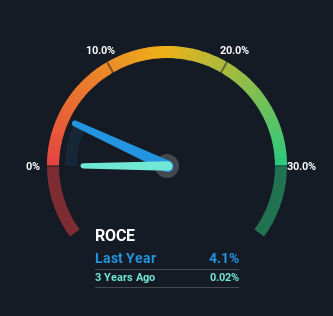Stoneridge (NYSE:SRI) Will Be Looking To Turn Around Its Returns
Ignoring the stock price of a company, what are the underlying trends that tell us a business is past the growth phase? Typically, we'll see the trend of both return on capital employed (ROCE) declining and this usually coincides with a decreasing amount of capital employed. Trends like this ultimately mean the business is reducing its investments and also earning less on what it has invested. In light of that, from a first glance at Stoneridge (NYSE:SRI), we've spotted some signs that it could be struggling, so let's investigate.
Understanding Return On Capital Employed (ROCE)
If you haven't worked with ROCE before, it measures the 'return' (pre-tax profit) a company generates from capital employed in its business. The formula for this calculation on Stoneridge is:
Return on Capital Employed = Earnings Before Interest and Tax (EBIT) ÷ (Total Assets - Current Liabilities)
0.041 = US$20m ÷ (US$675m - US$180m) (Based on the trailing twelve months to March 2024).
So, Stoneridge has an ROCE of 4.1%. In absolute terms, that's a low return and it also under-performs the Auto Components industry average of 12%.
Check out our latest analysis for Stoneridge
In the above chart we have measured Stoneridge's prior ROCE against its prior performance, but the future is arguably more important. If you'd like, you can check out the forecasts from the analysts covering Stoneridge for free.
What Does the ROCE Trend For Stoneridge Tell Us?
There is reason to be cautious about Stoneridge, given the returns are trending downwards. Unfortunately the returns on capital have diminished from the 16% that they were earning five years ago. And on the capital employed front, the business is utilizing roughly the same amount of capital as it was back then. Companies that exhibit these attributes tend to not be shrinking, but they can be mature and facing pressure on their margins from competition. So because these trends aren't typically conducive to creating a multi-bagger, we wouldn't hold our breath on Stoneridge becoming one if things continue as they have.
The Bottom Line On Stoneridge's ROCE
All in all, the lower returns from the same amount of capital employed aren't exactly signs of a compounding machine. Investors haven't taken kindly to these developments, since the stock has declined 49% from where it was five years ago. Unless there is a shift to a more positive trajectory in these metrics, we would look elsewhere.
Like most companies, Stoneridge does come with some risks, and we've found 2 warning signs that you should be aware of.
While Stoneridge may not currently earn the highest returns, we've compiled a list of companies that currently earn more than 25% return on equity. Check out this free list here.
Have feedback on this article? Concerned about the content? Get in touch with us directly. Alternatively, email editorial-team (at) simplywallst.com.
This article by Simply Wall St is general in nature. We provide commentary based on historical data and analyst forecasts only using an unbiased methodology and our articles are not intended to be financial advice. It does not constitute a recommendation to buy or sell any stock, and does not take account of your objectives, or your financial situation. We aim to bring you long-term focused analysis driven by fundamental data. Note that our analysis may not factor in the latest price-sensitive company announcements or qualitative material. Simply Wall St has no position in any stocks mentioned.
Have feedback on this article? Concerned about the content? Get in touch with us directly. Alternatively, email editorial-team@simplywallst.com

 Yahoo Finance
Yahoo Finance 
